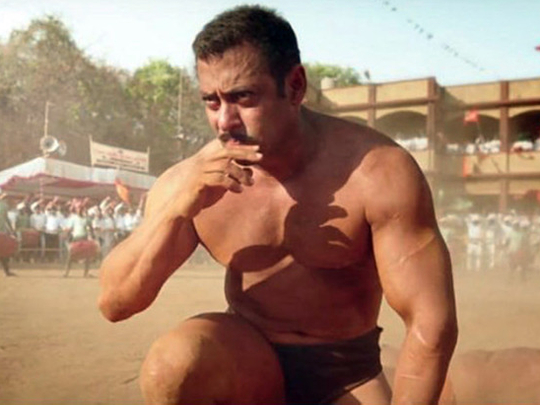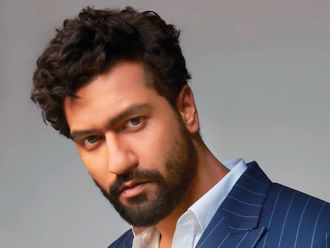
Salman Khan plays the title character in Sultan, an Eid release that premiered its trailer on Tuesday. Khan plays a wrestler who goes on to win a gold medal for India, leaves wrestling and returns to the sport older and lacking in fitness. He then is coached by Randeep Hooda’s character in MMA and reaches the big leagues.
The actor, joined by his co-star, Anushka Sharma, and director, Ali Abbas Zafar, launched the trailer in Mumbai. Here’s ten things they told us about it, including what made Khan cry on set. The film is out in the UAE on July 7.
He cried on set.
“The most difficult part was the langot [a small loincloth worn by wrestlers]. Now I understand what the actress goes through when they wear [a] swimsuit. When I was told I have to wear a langot, I thought ‘I can do that’. When I reached there, we saw like a 5,000 [person] crowd and I was like ‘no way I am doing this’. While I was walking out of the vanity van, I was in tears ... I feel violated.
“I was never ashamed while removing my shirt but this was the most difficult thing and thank God, people got used to it.”
Ali Abbas Zafar wanted to make ‘Sultan’ only with Khan.
“I think I am fortunate enough to work with Salman sir. Whenever you write a character you visualise an actor thinking he can pull it off well. Our producer Aditya Chopra and I were very clear that we would do this film only if Salman sir agrees to do it.”
The director narrated about 20 minutes of the film to Khan. “Whenever you go to a star with a character, you think if the character justifies the stardom of the star. He has worked with so many directors. His career spans over 25 years so he has lot of experience and you can’t ignore it.”
Khan contributed to the story.
“There is lot of Salman in the film because his contribution to the text is phenomenal,” says Zafar. “He never pointed bigger things to me, he pointed smaller things. My learning from this film is that the depth of things lies in small things.”
Khan doesn’t like to look back.
“I am fighting with myself all the time. I constantly try to up my standard a little bit. That is the only thing I keep fighting. I don’t have time to look behind. I try and take small baby steps. Whatever wrong I have done I am trying to cut it down, and whatever good I am doing I am trying to increase that level.”
He has not learnt the Haryanvi language.
“I have not learnt it. The dialogues used to come and I used to repeat it. [co-star Anushka Sharma] learnt Haryanvi and she speaks really well.”
“We just got the accent right, we had a coach for it,” adds Sharma.
Location shoots: Not fun.
“There is nothing better than shooting at real locations if things are controlled. But today, it is difficult to shoot at real locations because the amount of crowd, police security is there, it’s huge, so its difficult. So, we shot on sets and little bit on real locations,” Khan said.
This was a challenging film.
“It was a difficult journey. When this role was narrated to me I felt I can do this, but when I started doing it, the director got all real wrestlers in front of me. It was difficult.” A train sequence in Haryana was especially difficult. “We shot there for one day and they were all running shots. I got the pleasure to run with the steam engine. It was difficult to run and get the expressions right at the same time. It was a tiresome experience.”
Sultan is a simple man who has no ambitions.
“He sees a feisty girl [Sharma] and likes her and wants to marry her. But things don’t fall in place. She is a strong-headed girl. She is responsible for making him, breaking him and then again making him. This is the love story,” Khan says.
Most of the fights in the film are real.
“When Ali narrated to the me the story I thought I’ll be able to do it. But then while doing it, opposite me were not fighters but real wrestlers. Most of the shots in the film are real, wrestlers and Mixed Marital Arts [fighters], there are no cables and because of them there is lot of contact happening in the film. When they lift you and put [you on] the ground it used to hurt, they were 120-130kg,” he said.
“They expect you to pick you up and throw you down. That was the most difficult part. When a wrestler trains he trains for 2-3 hours and then 2-3 hours again in the evening, then training for MMA, and 6-7 hours of shoot every day non-stop, fighting non-stop. So those six hours in those lights and training, that used to take a toll.”
Sharma, too, learnt the moves. “I am very happy I did it as now if I see wrestling, I will come to know how it happens. I am grateful for the opportunity. I was sure we will not use body-double. I felt if I have learnt something, I want to show it properly. I worked hard and I am happy I got to do it.”
Is it inspired from a real-life character?
“No, it’s not from anywhere. This is from his [Zafar’s] mind. It is the story of an underdog,” says Khan.












